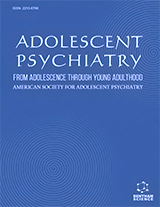Abstract
Background: Unmet mental health needs can lead to worsening outcomes in youth. Given that youth depend on family for access to mental health services, and positive family functioning is associated with improved health outcomes, understanding the association between family-level factors and youth’s unmet mental health needs is essential to inform appropriate solutions.
Objective: This study aimed to examine the association between family functioning (parental aggravation, parent-child communication, family resilience) and unmet mental health needs among school-aged youth.
Methods: A cross-sectional analysis of the combined 2019-2020 National Survey on Children’s Health (NSDH) dataset was performed (n=9,204). Bivariate and multivariate logistic regression models were used to examine the association between unmet mental health needs (primary outcome) and family functioning using three explanatory variables, parental aggravation, parent-child communication, and family resilience. We also examined age-related differences in these associations between children aged 6-11 and adolescents aged 12-17.
Results: The weighted proportion of youth with reported unmet mental health needs was 18%. Weighted unadjusted analyses showed that low family resilience was associated with 60% higher odds of unmet mental health needs, while parental aggravation and poor parentchild communication were not associated with unmet mental health needs. After adjusting for potential confounders, low family resilience was associated with 50% higher odds of unmet mental health needs among school-aged youth (AOR=1.53, 95% CI: 1.15-2.05). Being Black (AOR=2.29, 95% CI: 1.42-3.70), younger (AOR=0.95, 95% CI: 0.91-0.99), lacking consistent health insurance (AOR=2.68, 95% CI: 1.62-4.44), and having a mother with poor maternal health (AOR=1.84, 95% CI: 1.36-2.47), were also associated with unmet mental health needs. Among children aged 6-11 years, low family resilience, being Black, lacking consistent insurance, and having a mother with poor maternal health were associated with unmet mental health needs (all p’s<0.05). Similarly, among adolescents aged 12-17 years, low family resilience, being Black, lacking consistent insurance, and having a mother with poor maternal health were associated with unmet mental health needs (all p<0.05). Having a parent with a college education was associated with lower odds of unmet mental health needs among children (6-11 years), but not adolescents (12-17 years).
Conclusion: Our findings have suggested an association between low family resilience and unmet mental health needs among school-aged youth. Since families are an integral part of meeting youth’s needs, applying approaches to addressing unmet mental health needs that consider family resilience and parental well-being is imperative. Identifying and addressing factors contributing to unmet health needs barriers may help address existing racial disparities.
[http://dx.doi.org/10.1377/hlthaff.2018.05425] [PMID: 31059374]
[http://dx.doi.org/10.1080/02673843.2017.1299016]
[http://dx.doi.org/10.1177/1074840707312237] [PMID: 18281642]
[http://dx.doi.org/10.1037/0012-1649.22.6.723]
[http://dx.doi.org/10.1111/j.1447-0349.2011.00782.x] [PMID: 22221413]
[http://dx.doi.org/10.1007/s40615-023-01801-4] [PMID: 37737936]
[http://dx.doi.org/10.3389/fpsyt.2021.709516] [PMID: 34539463]
[http://dx.doi.org/10.1177/1062860610390352] [PMID: 21478458]
[http://dx.doi.org/10.58464/2168-670X.1009]
[http://dx.doi.org/10.1007/978-1-4020-5779-3_18]
[http://dx.doi.org/10.1007/978-1-4614-3917-2_8]
[http://dx.doi.org/10.1017/S0033291797005412] [PMID: 9300518]
[http://dx.doi.org/10.1542/peds.2019-1975] [PMID: 31949000]
[http://dx.doi.org/10.1136/bmjopen-2018-024870] [PMID: 30975671]
[http://dx.doi.org/10.1016/j.psychres.2015.04.004] [PMID: 25895487]
[http://dx.doi.org/10.1016/j.childyouth.2021.106103]
[http://dx.doi.org/10.1016/j.chiabu.2009.01.002] [PMID: 19804905]
[http://dx.doi.org/10.1002/nur.22066]
[http://dx.doi.org/10.3109/01460862.2012.678261] [PMID: 22545691]
[http://dx.doi.org/10.1016/S0165-0327(00)00175-0] [PMID: 11246092]
[http://dx.doi.org/10.1177/1367493517748372] [PMID: 29262717]
[http://dx.doi.org/10.1176/ajp.151.4.530] [PMID: 8147450]
[http://dx.doi.org/10.1176/appi.ajp.159.9.1548] [PMID: 12202276]
[http://dx.doi.org/10.1080/07399332.2019.1615917] [PMID: 31246155]
[http://dx.doi.org/10.3390/children9020241] [PMID: 35204961]
[http://dx.doi.org/10.1002/nur.21725] [PMID: 27128982]
[http://dx.doi.org/10.1097/DBP.0000000000000363] [PMID: 27801721]
[http://dx.doi.org/10.1111/jftr.12255]
[http://dx.doi.org/10.1111/camh.12515] [PMID: 34653306]
[http://dx.doi.org/10.1007/s10826-020-01784-4]
[http://dx.doi.org/10.1016/j.pedneo.2022.03.018] [PMID: 35787360]
[http://dx.doi.org/10.1016/S0006-3223(98)00144-9] [PMID: 9693391]
[http://dx.doi.org/10.1177/1468017314568081]
[http://dx.doi.org/10.1007/s10578-021-01243-1] [PMID: 34533667]
[http://dx.doi.org/10.1016/j.dhjo.2010.09.002] [PMID: 21723521]
[http://dx.doi.org/10.1177/0004867417707818] [PMID: 28486819]
[http://dx.doi.org/10.1177/1066480705278724]
[http://dx.doi.org/10.1177/2381468318760298] [PMID: 30288438]
[http://dx.doi.org/10.1007/s10995-022-03569-1] [PMID: 36662381]
[http://dx.doi.org/10.1016/j.jadohealth.2013.11.004] [PMID: 24388108]
[PMID: 18422048]
[http://dx.doi.org/10.1016/j.jad.2020.03.132] [PMID: 32379600]
[http://dx.doi.org/10.1001/jamanetworkopen.2018.5217] [PMID: 30646382]
[http://dx.doi.org/10.1016/j.pedn.2022.05.014] [PMID: 35640485]
[http://dx.doi.org/10.1111/jocn.14500] [PMID: 29700875]




























